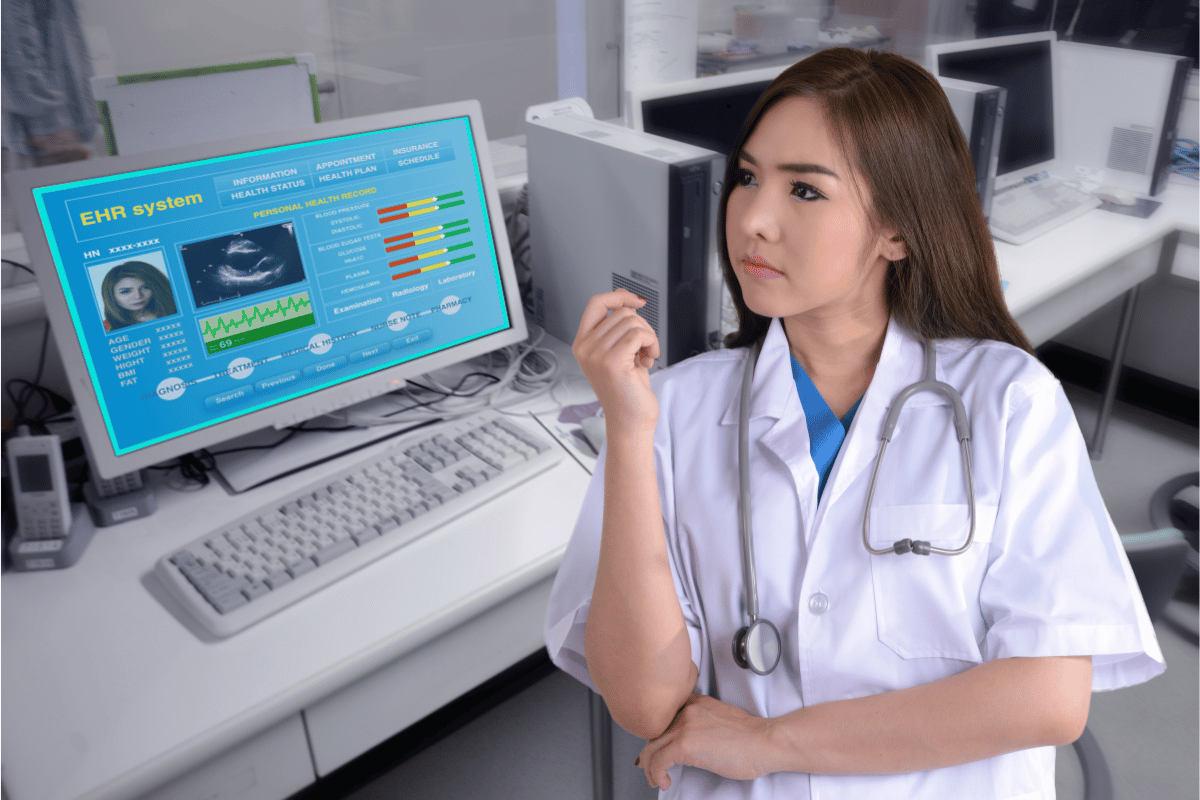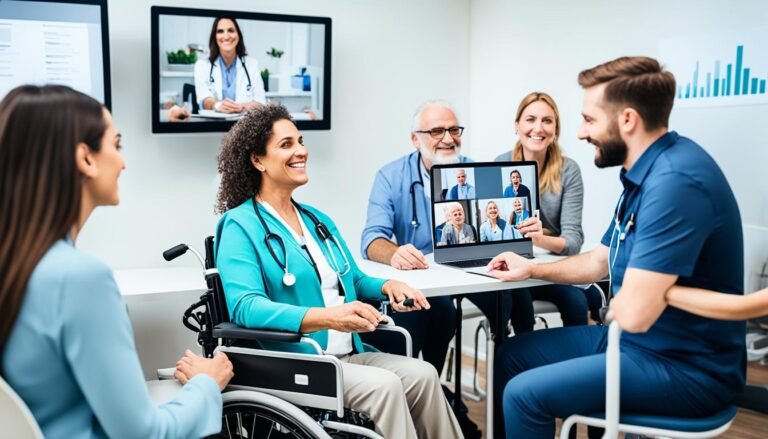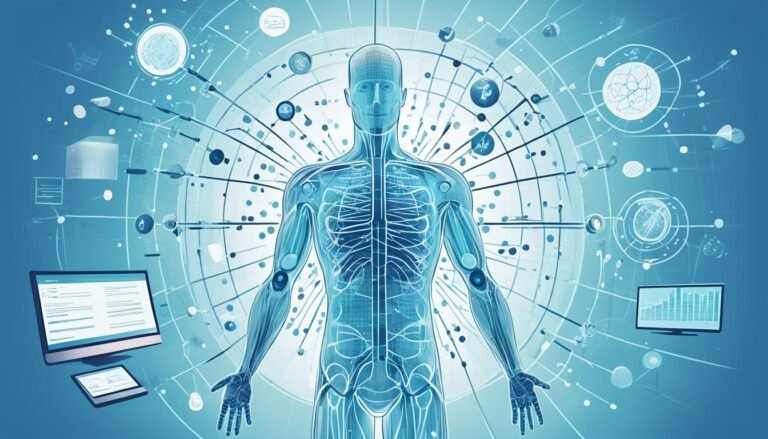The Patient and Provider Interface: Navigating EHR Communications
In the ever-evolving landscape of healthcare, effective communication between patients and providers is the compass that guides the course of care. As the digital age continues to shape the way we interact, Electronic Health Record (EHR) systems have emerged as a pivotal tool in this communication journey.
This article explores the intricate relationship between patients and providers in navigating EHR communications, delving into the importance of clear and concise interactions, overcoming barriers, and leveraging technology for streamlined and secure exchanges.
Key Takeaways
- Effective EHR communication facilitates efficient and accurate exchange of information between patients and healthcare providers.
- Patient privacy concerns are crucial in EHR communications.
- Strategies for effective patient-provider communication include using plain language, active listening, and clear and concise language.
- EHRs streamline communication, provide real-time access to patient information, and enhance provider-patient collaboration.
The Importance of Effective EHR Communication
Effective EHR communication plays a crucial role in facilitating efficient and accurate exchange of information between patients and healthcare providers. In today’s healthcare landscape, where technology is increasingly integrated into all aspects of patient care, effective communication is essential for ensuring patient satisfaction and delivering high-quality care.
One of the key benefits of effective EHR communication is improved patient satisfaction. When patients have access to their electronic health records and can communicate with their healthcare providers through secure messaging systems, they feel more engaged and involved in their own care. This leads to increased satisfaction as patients have a better understanding of their medical conditions, treatment plans, and progress.
Furthermore, effective EHR communication enables healthcare providers to deliver more personalized care. By having access to comprehensive patient information, including medical history, test results, and treatment plans, providers can make more informed decisions and tailor their approach to each individual patient. This not only improves patient outcomes but also fosters a stronger patient-provider relationship based on trust and collaboration.
In addition, effective EHR communication leads to improved coordination of care among healthcare providers. With the ability to easily share patient information and communicate electronically, providers can work together more seamlessly, reducing errors, duplication of tests, and unnecessary delays. This ultimately leads to more efficient and cost-effective care delivery.
Understanding the Patient Perspective in EHR Communications
Understanding the patient perspective in EHR communications is crucial for effective healthcare delivery.
One key aspect is patient privacy concerns, as patients want reassurance that their personal health information is secure.
Additionally, effective patient-provider communication is essential to build trust, address concerns, and ensure that patients actively participate in their own healthcare decisions.
Patient Privacy Concerns
A significant number of patients express concerns about their privacy when it comes to EHR communications. One of the main worries is the potential for data breaches, where sensitive medical information could be accessed by unauthorized individuals. Patients fear that their personal health details could be exposed, leading to potential identity theft or discrimination.
Another concern is the issue of patient consent. Patients want to have control over who can access their electronic health records and for what purposes. They want to be able to provide informed consent and have the ability to revoke access if they feel it necessary.
These privacy concerns highlight the importance of implementing robust security measures and ensuring that patients are fully informed and involved in the management of their electronic health records.
Effective Patient-Provider Communication
The patient’s perspective in EHR communications plays a crucial role in establishing effective communication between patients and providers. Patient satisfaction relies heavily on the ability to effectively communicate with their healthcare providers through electronic health record (EHR) systems.
To ensure a positive patient experience, healthcare providers must employ effective communication strategies when using EHRs. One such strategy is the use of plain language that is easily understood by patients. Avoiding medical jargon and using clear and concise language can help patients better comprehend their health information and treatment plans.
Additionally, providers should actively listen to patients, allowing them to express their concerns and ask questions. This not only enhances patient satisfaction but also promotes a collaborative and patient-centered approach to healthcare.
Enhancing Provider-Patient Collaboration Through EHRs
Enhancing provider-patient collaboration through electronic health records (EHRs) is crucial for improving healthcare communication and enhancing patient engagement.
By utilizing EHRs, healthcare providers can streamline communication, access patient information in real-time, and involve patients in their own care.
This collaboration promotes a more patient-centered approach, leading to better healthcare outcomes and increased patient satisfaction.
Improving Healthcare Communication
Effective utilization of EHRs can significantly enhance provider-patient collaboration in healthcare communication. By streamlining communication processes and improving access to patient information, EHRs have the potential to improve patient satisfaction and overcome communication barriers that may exist in traditional healthcare settings.
One of the main benefits of EHRs is the ability for providers to have real-time access to a patient’s medical history, test results, and treatment plans. This comprehensive view allows for more informed decision-making and personalized care.
Additionally, EHRs can facilitate secure messaging between patients and providers, enabling timely communication and reducing the need for in-person visits for minor issues or follow-ups.
However, it is important to recognize that the implementation of EHRs can also introduce new challenges. Providers must ensure that the technology is user-friendly and does not disrupt the natural flow of patient interaction. Adequate training and support are essential to ensure that providers can effectively navigate the EHR system and use it to enhance communication with patients.
Enhancing Patient Engagement
Healthcare providers can leverage EHRs to foster greater patient engagement and collaboration. By utilizing digital tools and incorporating patient empowerment strategies, providers can enhance their communication with patients and improve overall healthcare outcomes.
Here are four ways in which EHRs can enhance patient engagement:
- Access to medical records: EHRs allow patients to have secure access to their medical records, enabling them to stay informed and actively participate in their healthcare decisions.
- Online appointment scheduling: EHRs can offer patients the convenience of scheduling appointments online, reducing wait times and streamlining the patient experience.
- Secure messaging: EHRs enable secure messaging between patients and healthcare providers, facilitating quick and efficient communication for non-urgent inquiries or follow-up questions.
- Patient education resources: EHRs can provide patients with access to educational materials and resources, empowering them to make informed decisions about their health and treatment options.
Through the effective use of EHRs and digital tools, healthcare providers can enhance their collaboration with patients, promoting patient engagement and improving healthcare outcomes.
Overcoming Barriers to Effective EHR Communication
In order to improve the exchange of information between patients and healthcare providers, it is necessary to address the obstacles that hinder effective communication in electronic health record (EHR) systems. These barriers can lead to inefficiencies and communication gaps that can negatively impact patient care. By identifying and overcoming these obstacles, healthcare organizations can enhance the overall quality of care provided to patients.
One of the main barriers to effective EHR communication is the lack of interoperability between different EHR systems. When healthcare providers use different systems that do not seamlessly exchange information, it can result in fragmented patient records and missed opportunities for collaboration. Standardizing data formats and implementing interoperable EHR systems can significantly improve efficiency and facilitate better communication between providers.
Another challenge is the complexity and usability of EHR systems. Providers often face difficulties navigating through the various features and functionalities of these systems, which can lead to errors and delays in communication. Simplifying the user interface and providing comprehensive training can help address these challenges and improve the overall user experience.
Additionally, privacy and security concerns can hinder effective EHR communication. Patients may be hesitant to share sensitive information electronically, fearing breaches in confidentiality. Implementing robust security measures, such as encryption and access controls, can help alleviate these concerns and build trust between patients and providers.
By addressing these barriers, healthcare organizations can enhance the exchange of information in EHR systems, improving efficiency and ultimately, patient outcomes.
| Barriers to Effective EHR Communication | Solutions |
|---|---|
| Lack of interoperability | Standardize data formats and implement interoperable EHR systems |
| Complexity and usability of EHR systems | Simplify user interface and provide comprehensive training |
| Privacy and security concerns | Implement robust security measures and build trust through transparency |
Strategies for Clear and Concise EHR Communication
When it comes to EHR communication, simplifying complex medical jargon is crucial. By using plain language that patients can understand, healthcare providers can enhance patient-provider understanding and promote better communication.
Additionally, streamlining EHR communication processes can help eliminate unnecessary information and ensure that key information is effectively communicated between providers and patients.
Simplifying Complex Medical Jargon
Streamlining complex medical jargon is essential for effective EHR communication. Simplifying terminology is crucial to ensure patient comprehension and facilitate meaningful interactions between healthcare providers and patients.
Here are some strategies to simplify complex medical jargon:
- Use plain language: Avoid technical terms and explain medical concepts in simple, everyday language.
- Visual aids: Utilize diagrams, charts, and images to enhance understanding and simplify complex information.
- Analogies: Use familiar analogies to explain medical terms or procedures in a relatable way.
- Patient education materials: Provide patients with written materials that explain medical terms and procedures in a clear and concise manner.
Implementing these strategies can help bridge the communication gap between healthcare providers and patients, fostering better understanding and engagement in the healthcare process.
Enhancing Patient-Provider Understanding
One effective strategy for enhancing patient-provider understanding in EHR communication is to utilize specific language that clearly conveys information. By using language that is concise and avoids complex medical jargon, patients are more likely to understand the information being communicated to them.
Effective communication techniques such as using plain language, avoiding abbreviations, and providing explanations and examples can empower patients to actively participate in their own healthcare. When patients understand their medical information, they are better equipped to make informed decisions about their treatment options and engage in meaningful discussions with their healthcare providers.
Clear and concise EHR communication can also help to build trust and strengthen the patient-provider relationship, leading to improved patient satisfaction and better health outcomes.
Streamlining EHR Communication
How can healthcare providers effectively streamline EHR communication to ensure clear and concise information exchange?
Improving efficiency and optimizing workflows are key goals in streamlining EHR communication. Here are some strategies to achieve this:
- Standardize communication protocols: Establishing standardized formats and templates for EHR communication can help ensure consistency and clarity in information exchange.
- Implement decision support tools: Integrating decision support tools into the EHR system can assist healthcare providers in making informed decisions and reducing the time spent searching for relevant information.
- Automate documentation processes: Automating the documentation process can help reduce manual data entry, minimize errors, and improve overall efficiency in EHR communication.
- Enhance interoperability: Improving interoperability between different EHR systems can facilitate seamless communication and exchange of patient information across healthcare settings.
The Role of EHR Training in Improving Communication
EHR training plays a pivotal role in enhancing communication between healthcare providers and patients. With the increasing use of electronic health records (EHRs) in healthcare settings, proper training on how to effectively navigate and utilize these systems is essential. EHR training benefits both providers and patients by improving communication skills and facilitating better patient care.
One of the key benefits of EHR training is that it helps healthcare providers develop strong communication skills. During training, providers learn how to effectively document patient encounters, ensuring that essential information is accurately recorded. This documentation can then be easily accessed and shared with other providers, enhancing communication and collaboration among the healthcare team. Additionally, EHR training equips providers with the knowledge and skills to effectively communicate with patients through the system. This includes explaining test results, treatment plans, and answering patient questions or concerns. Improved communication skills lead to better patient understanding and engagement in their own care.
Privacy and Security Considerations in EHR Communications
The privacy and security considerations of EHR communications are crucial for protecting patient information and ensuring confidentiality. With the increasing use of electronic health records (EHRs), it is essential to address the potential risks associated with the transmission and storage of sensitive patient data.
To safeguard patient privacy and maintain the security of EHR communications, healthcare organizations must implement various measures, including:
- Strict Access Controls: Limiting access to EHRs to authorized individuals and implementing strong authentication measures, such as password policies and two-factor authentication, can help prevent unauthorized access.
- Encryption: Encrypting EHR data during transmission and storage adds an extra layer of protection, making it difficult for unauthorized individuals to read or modify the information.
- Regular Audits and Monitoring: Conducting regular audits and monitoring EHR systems allows healthcare organizations to identify and address any potential security vulnerabilities or breaches promptly.
- Patient Consent: Obtaining patient consent before sharing their medical records electronically is essential. It ensures that patients are aware of how their information will be used and gives them control over their data.
Despite these measures, the risk of data breaches always exists. In the event of a breach, healthcare organizations must have an incident response plan in place to minimize the impact and notify affected individuals promptly.
Leveraging Technology for Streamlined EHR Communication
To enhance efficiency and improve communication in EHR systems, healthcare providers can leverage technology for streamlined workflows and seamless information exchange. By incorporating advanced tools and software solutions, providers can significantly improve the efficiency and effectiveness of their EHR communication processes.
One key way technology can be leveraged is through the use of secure messaging platforms. These platforms allow providers to securely communicate with each other and exchange patient information in real-time, eliminating the need for phone calls, faxes, or other traditional forms of communication. This not only saves time but also reduces the risk of miscommunication or errors.
Another technology that can be utilized is electronic prescribing systems. These systems allow providers to electronically send prescriptions to pharmacies, eliminating the need for paper prescriptions and reducing the risk of medication errors. Additionally, these systems can provide alerts for potential drug interactions or allergies, further improving patient safety.
Furthermore, the use of telemedicine technology can greatly enhance EHR communication. Telemedicine allows providers to conduct virtual visits with patients, enabling them to remotely review medical records, discuss treatment plans, and provide necessary care. This not only improves efficiency by eliminating the need for in-person visits but also enhances patient convenience and access to healthcare.
Incorporating technology into EHR communication processes is vital for improving efficiency and ensuring seamless information exchange. By leveraging these tools, healthcare providers can streamline workflows, enhance patient care, and improve overall communication within the healthcare system.
| Technology | Benefits |
|---|---|
| Secure messaging platforms | Real-time communication |
| Reduced risk of errors or miscommunication | |
| Electronic prescribing | Elimination of paper prescriptions |
| systems | Reduced risk of medication errors |
| Telemedicine technology | Virtual visits for improved access to care |
| Efficient review of medical records | |
| Convenience for patients |
Best Practices for Documenting Patient Information in EHRs
Accurate and thorough documentation of patient information is essential for effective communication and continuity of care in electronic health record systems. To ensure the best practices for documenting patient information in EHRs, healthcare providers should consider the following strategies:
- Standardization: Implement standardized templates and guidelines for documenting patient information to promote consistency and improve the quality of documentation.
- Clarity and Precision: Use clear and concise language to convey patient information accurately. Avoid ambiguous terms or abbreviations that may lead to misinterpretation.
- Timeliness: Document patient information in real-time to ensure the most up-to-date and accurate data. Delayed documentation can lead to errors and hinder effective communication between healthcare providers.
- Training and Education: Provide comprehensive training to healthcare providers on proper documentation practices. This includes educating them on the importance of thorough documentation, as well as the potential barriers and challenges they may face.
Despite the benefits of accurate and thorough documentation, there are potential barriers that healthcare providers may encounter. These barriers include time constraints, limited EHR functionality, and user interface challenges.
The Future of EHR Communications: Trends and Innovations
Emerging technologies and advancements in healthcare are shaping the future of EHR communications. As the healthcare industry continues to evolve, there are several trends and innovations that are expected to have a significant impact on the way electronic health records (EHRs) are communicated.
One of the trends in EHR communications is the rise of interoperability. Interoperability allows different EHR systems to seamlessly exchange patient information, enabling healthcare providers to access comprehensive and up-to-date patient records. This innovation improves patient care by providing a holistic view of a patient’s medical history, regardless of where the information originates.
Another trend in EHR communications is the increasing use of mobile applications. Mobile apps provide a convenient way for patients to access their health records and communicate with their healthcare providers. These apps can also enable secure messaging, appointment scheduling, and prescription refills, making healthcare more accessible and efficient for patients.
Artificial intelligence (AI) is also expected to play a significant role in the future of EHR communications. AI can analyze large amounts of patient data to identify patterns and trends, helping healthcare providers make more accurate diagnoses and treatment decisions. Additionally, AI-powered chatbots can assist patients by answering common questions and providing basic medical advice.
Conclusion
In conclusion, effective EHR communication plays a critical role in enhancing patient-provider collaboration and improving healthcare outcomes.
By understanding the patient perspective and implementing strategies for clear and concise communication, healthcare providers can overcome barriers and ensure privacy and security.
Leveraging technology and adopting best practices for documenting patient information in EHRs are key for streamlined communication.
As the future of EHR communications evolves, embracing trends and innovations will further enhance the patient and provider interface, ultimately leading to better healthcare delivery.





